Samsung Galaxy S III Performance Preview: It's Fast
by Brian Klug & Anand Lal Shimpi on May 3, 2012 6:13 PM EST- Posted in
- Smartphones
- Samsung
- Mobile
- SoCs
- Exynos 4 Quad
- Galaxy S III
Earlier today Samsung unveiled its Galaxy S III, at the heart of which is Samsung's new Exynos 4 Quad SoC. Fortunately we got a ton of hands on time with the device at Samsung's unpacked event in London and are able to bring you a full performance preview of the new flagship, due to be shipping in Europe on May 29th.
The Exynos 4 Quad is an obvious evolution of the dual-core Exynos in many of the Galaxy S II devices. Built on Samsung's 32nm high-k + metal gate LP process, the new Exynos integrates four ARM Cortex A9s running at up to 1.4GHz (200MHz minimum clock). Each core can be power gated individually to prevent the extra cores from being a power burden in normal usage. Each core also operates on its own voltage and frequency plane, taking a page from Qualcomm's philosophies on clocking. There is no fifth companion core, but the assumption is Samsung's 32nm HK+MG LP process should have good enough leakage characteristics to reduce the need for such a design.
The GPU is still ARM's Mali-400/MP4, however we're not sure of its clocks. Similar to the dual-core Exynos, there's a dual-channel LPDDR2 memory controller that feeds the entire SoC. The combination should result in performance competitive with NVIDIA's Tegra 3 (and a bit higher in memory bandwidth limited scenarios), but potentially at lower power levels thanks to Samsung's 32nm process.
While we won't know much about the power side of things until we get a review device in hand, we can look at its performance today.
Browser & CPU Performance: Very Good
As always, we start with our Javascript performance tests that measure a combination of the hardware's performance in addition to the software on the device itself. Sunspider performance is extremely good:
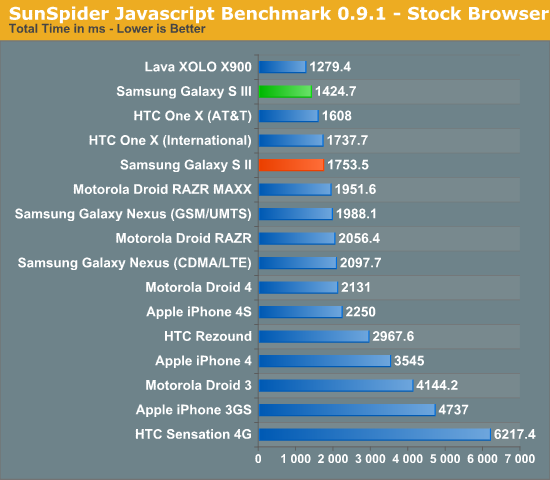
While we thought we hit a performance wall around 1800ms, the One X from HTC, the Lava XOLO and now the Samsung Galaxy S III have reset the barrier for us. In this case the performance boost is likely more due to software than hardware, but the combination of the two results in performance that's better than almost anything we've seen thus far. The obvious exception being Intel's Medfield in the X900.
BrowserMark is another solid js benchmark, but here we're really able to see just how much tuning Samsung has done in its browser:
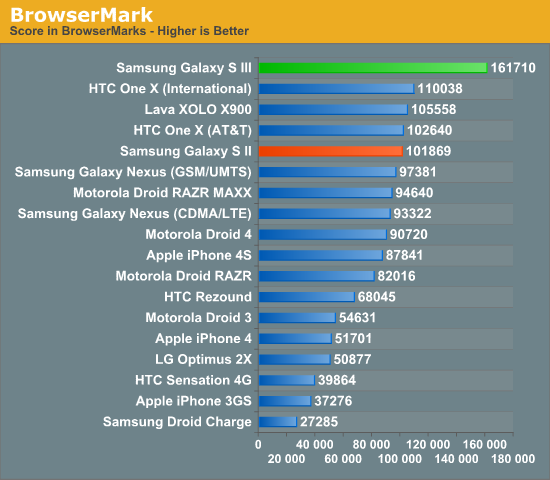
The Galaxy S III is significantly faster than anything else we've ever tested thus far. The browsing experience in general is very good on the SGS3, and the advantage here likely has more to do with Samsung's browser code and the fact that it's running Android 4.0.4 rather than any inherent SoC advantage. We know how 1.4GHz Cortex A9s should perform, and this is clearly much better than that.
Once again we turn to Qualcomm's Vellamo to get an idea for browser and UI scrolling performance:

Although (understandably) not as quick as the Snapdragon S4 based One X, the SGS3 does extremely well here - likely due in no small part to whatever browser optimizations ship in Samsung's 4.0.4 build. As Brian put it when he first got time with the device: it's butter.
GPU Performance: Insanely Fast
While we don't know the clocks of the Mali-400/MP4 GPU in the SGS3, it's obviously significantly quicker than its predecessor. Similar to what we saw when the Galaxy S II launched, Samsung once again takes the crown for fastest smartphone GPU in our performance tests.
The onscreen GLBenchmark Egypt and Pro results are understandably v-sync limited, but if you look at how much headroom is available thanks to the faster GPU it's clear that the Galaxy S III should be able to handle newer, more complex games, better than its predecessor.
What's particularly insane is that Samsung is able to deliver better performance than the iPhone 4S, the previous king-of-the-GPU-hill in these tests.
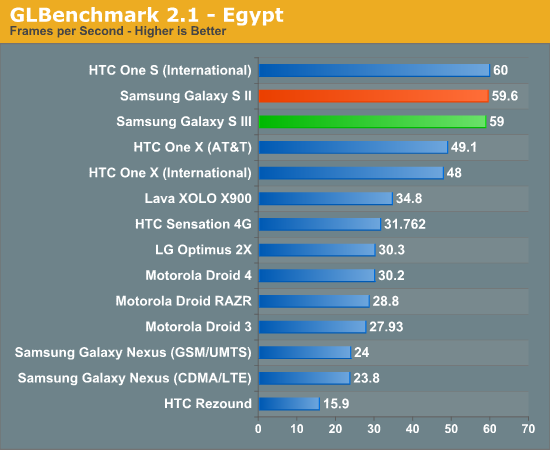
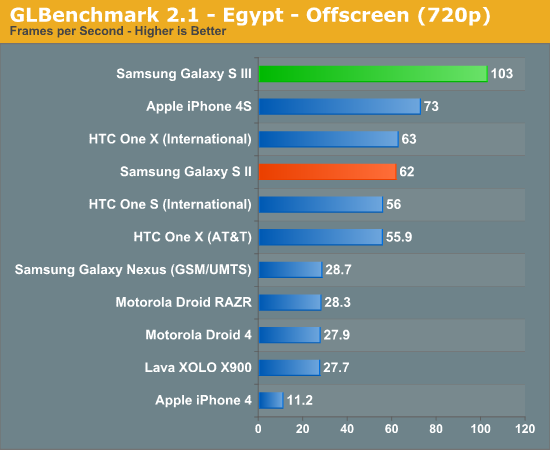
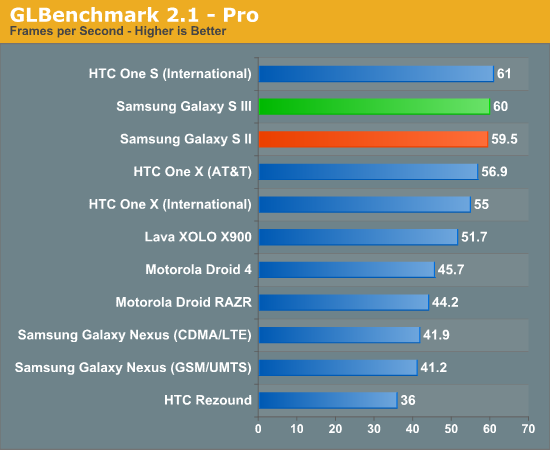
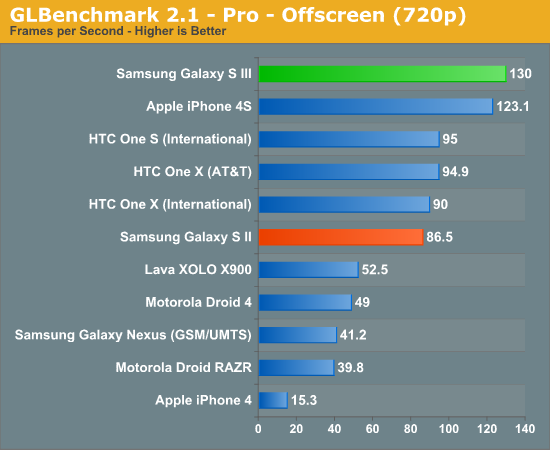
The performance advantage isn't anywhere near as staggering if we look as BaseMark ES 2.0, however as we've mentioned before this benchmark is definitely showing its age at this point. Despite the aggressive tuning Qualcomm has done for these benchmarks, Samsung is actually able to remain competitive and even pull out a slight win in the Taiji test. Both benchmarks are v-sync limited on the fastest platforms however.
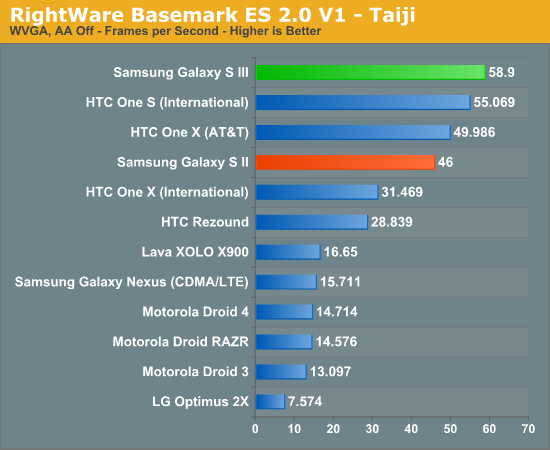
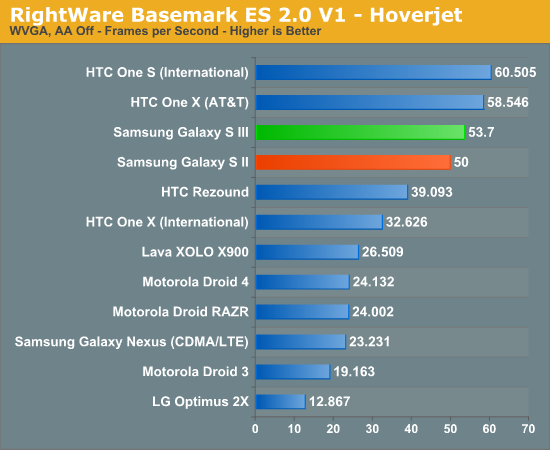
Final Words
Our first interactions with Samsung's Exynos 4 Quad are promising, but there's still much more to understand. Samsung clearly used 32nm as a means to higher GPU clock speeds, which in turn gives us much better GPU performance. The big unknown, as always, is power consumption. Based on what we've seen thus far from Samsung's 32nm LP process in Apple's iPad 2,4 (review forthcoming), Exynos 4 Quad should be a pretty good step forward in the power department as well.
As soon as we can get our hands on final hardware you can expect a full review of the Galaxy S III, including power and battery life analysis.
Initial reactions to the Galaxy S III announcement seemed almost disappointing, however stay tuned for our hands on impressions of the device as well as even more depth/detail on the hardware platform - you may be surprised.















92 Comments
View All Comments
tipoo - Friday, May 4, 2012 - link
Introducing the Nebula Nexus with a hexacore processor...shompa - Friday, May 4, 2012 - link
So you think its an advantage that Microsoft can't deliver a multithreaded OS? They haven't managed to deliver a good multithreaded OS for X86 in over 30 years. A feature that have worked on Unix since late 1960 :)But you point is valid. Microsoft shows how much better integrated design is then fragmented. Since they dictate the hardware, they can optimize everything with GPU/SIMD.
Windows8 will be interesting. The fragmented X86 version Vs the integrated ARM version. The fragmented version needs 5-10 times the CPU power to active the same user experience as ARM for Windows.
Nerds love horse power. A quad 1.4ghz Vs single core 1 ghz have to be better. Just like a 400 hp car would be slower then a good designed 100HP car.
barefeats - Friday, May 4, 2012 - link
I'm a fan of the Apple iPhone 4S but I'm always looking "over the fence" to see how Android smartphones compare in raw performance. Until yesterday, the iPhone 4S was the fastest smartphone running GLBenchmark 2's Egypt Offscreen and "T-Rex" Pro Offscreen benchmarks -- fair tests since they force all devices to run at 1280x720 on a virtual screen. As you have shown with this article, the Samsung Galaxy S III is now the "King of Egypt."On another note, I'm wondering why the Galaxy S III does relatively poorly on the Linpack benchmark with a 102 Mflops rating (Multithreading). The HTC One X (AT&T) blows it away with a 215 Mflops rating. Even the iPhone 4S beats it with a 131 Mflops rating. Thoughts?
HotBBQ - Friday, May 4, 2012 - link
My guess in that the HTC One X has a Snapdragon S4 which is Cortex A15 based while the S3 is still Cortex A9.yjwong - Saturday, May 5, 2012 - link
Actually, Snapdragon S4 isn't based on Cortex A15. They do their own designs based on the ARMv7 instruction set. But yes, Krait shares most of the performance features with Cortex A15.Rowlf - Friday, May 4, 2012 - link
I believe it's all about the display. Does it really matter has fast it is if you can't see the screen. I can't be the only one using their phone outside.For me it's a basic interface issue. Apple and now it appears HTC gets it. The problem I see with pentile is lack of brightness and contrast. I don't spend all my time in a cave
Why can't someone beat apple when it comes to the display?
Rowlf - Friday, May 4, 2012 - link
Sorry for the typo. It should read "What about the display".ssddaydream - Saturday, May 5, 2012 - link
Lack of contrast?Any AMOLED has a insanely high contrast ratio. FAR above any LCD.
The reason LCD is easier to see outdoors is partially because of the reflection of the outdoor lighting off the display.
If you kill the back-light on an LCD panel, then put the display under direct sunlight, you can see the image, including some color.
I agree that any AMOLED display is difficult to see outdoors. It is just the nature of the tech. For outdoor use, LCD will likely reign king for some time.
Zoomer - Friday, May 4, 2012 - link
Question is, is it pentaband UMTS?1ceTr0n - Friday, May 4, 2012 - link
Can go back or buy a 4S then, Apple loves to have haters and trolls as customers